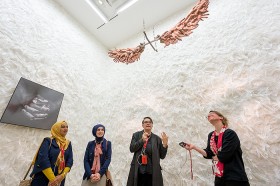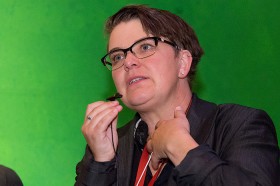Impressions of the “Obedience” Exhibition, from Muslim and Christian Perspectives
During the recent “Long Night of Museums” event, visitors were given a unique introduction to our current temporary exhibition “Obedience. An Installation in 15 Rooms by Saskia Boddeke & Peter Greenaway,” when the imam Emine Erol and the pastor Silke Radosh-Hinder led guided tours together. We asked the two women what they made of the occasion, and whether the joint guided tours had opened up novel views and perspectives on the biblical story.
Ms Erol, Ms Radosh-Hinder, would each of you describe the exhibition in your own words?
Silke Radosh-Hinder: For me, the exhibition is above all an opportunity to examine the story of the Binding of Isaac from a myriad of perspectives.
Emine Erol: The primary focus of the Obedience exhibition is the frame of mind of Ismael/Isaak respectively of his father Abraham. By prompting an emotional response and reflection, it helps visitors understand, ultimately, that such surrender may be dangerous or possibly even fatal—and also to understand what may motivate it.
This presents them with a new perspective on the topic. Avram or Abraham resolves to sacrifice his son in accordance with the oath he has sworn to God. Archeological finds show that many forms of human sacrifice were practiced in Abraham’s day and that is was not at all uncommon to sacrifice one’s first born son to a higher power.
Ismael, by contrast, is confronted with his nefs, to use the Islamic psychological term for the pure and perfect self at the core of a human being, the so-called ‘appetitive soul:’ a self that may equally fall prey to diabolic temptations. However, Ismael resists the call of his ego and is willing to be sacrificed. One reason for this may be his steadfast trust in the Prophet Abraham, who is also his father. Ultimately, at the bidding of a higher power, the act of sacrifice is not carried out.
Did any object, artwork or film in the exhibition particularly appeal to you or give you food for thought?
Erol: The white room with the name “God and the Angel” moved me deeply. There, one finds angels’ wings that are made from a multitude of human hands and hence suggest a direct relation to Allah. For angels were created from the light of Allah’s features and the arrival of the Angel Chibril or Gabriel on the scene completely changes the story of the sacrifice of Ismael, thereby marking a highlight in the Abraham/Ismael narrative. For me, it brought to mind the Surat Fatir, the thirty-fifth Sura of the Qur’an. I found the film about Sarah and Hagar thought-provoking too. Sarah is dressed in classy ‘European’ clothing, has blue eyes and white skin, and is a lot taller than Hagar, who has dark skin and black hair, and is dressed in rags that mark her as a slave. From the Muslim viewpoint this is a misrepresentation of Hagar given that the major sources portray her as a princess of royal blood.
Radosh-Hinder: The angels’ wings made of hands made a strong impression on me, too, but for another reason. They are far removed from the usual image of the sweet and charming angel. Also, the fact that the wings are made of disembodied hands seems a little bizarre or even repulsive. Otherwise, I was disappointed to find that oppositions such as ‘good’ and ‘bad,’ ‘black’ and ‘white,’ ‘angel’ and ‘devil’ are quite often simplified in the exhibition. Current discourse has actually already moved beyond that.
In your opinion, what is the central theological theme of the narrative?
Radosh-Hinder: The title of the exhibition, “Obedience,” is actually a very good choice, for it focuses attention on the core question: Which form of “Obedience” is actually called for in this highly dramatic narrative?
Erol: Salvation in the form of mercifulness and the revelation that follows on the moment of surrender! In this story Allah teaches humankind that human sacrifice is wrong. The aforementioned ritual, the human sacrifice still common in Abraham’s day, is bereft of meaning by the story of Abraham.
Which role does the Abraham story play in your daily work?
Erol: The Abraham story goes to the heart of what it is to be human, addresses the interplay of good and evil, and turns the spotlight on the matter of divine protection. In everyday life I strive to see what evil may be implicit in the things I regard as good, and vice versa. Abraham decides as a young man to reject the rituals and idolatry of his people. He manages to flee and his sole mainstay is his recognition of the uniqueness of the Lord. But is he aware of the fact that, in sacrificing his son, he lends credence to a human ritual?
Radosh-Hinder: This story is of consequence in my everyday life whenever power constellations come into play and bring up the question: Which is the voice of God, the voice in which we must so completely place our trust that we will act accordingly? It is crucial to answer this question in the light of the end of the Abraham story, which is to say, we must bear in mind that God does not want such sacrifice—and therefore prevents it.
In conclusion we would like to hear whether the exhibition and in particular the conversations you had about it during the “Long Night of Museums” opened up new perspectives on the story for you?
Radosh-Hinder: Absolutely! It has been a great experience that continues to have an effect on my thinking. The respectively diverse perspectives on the story and its reception within Judaism, Islam and Christianity never cease to throw up further questions. The specifically novel perspective for me touched on instances of identification: With whom does a religion or a religious community identify most strongly—and why? Certainly, to critically pursue this question in the light of such a major narrative has opened up new insights.
Erol: The guided tours led by Silke Radosh-Hinder and I, our joint reflection on how the story might be approached and interpreted, and our visitors’ outstanding questions inspired in me new insights and trains of thought. For example, at the very start, in the Angels’ Room, we discussed how various sources present the story. My memories of that are still vivid.
Emine Erol is a theologian and scholar of History of Religions, a spokeswoman on religious affairs for the Şehitlik Mosque in Berlin-Neuköln, and a representative of the Presidency of Religious Affairs of the Republic of Turkey; Silke Radosh-Hinder is Evangelist pastor and Deputy Superintendent of the Kirchenkreis [parish] of Berlin-Mitte. Questions by Signe Rossbach, who very much enjoyed accompanying our two guests on their guided tours of the exhibition.

